|
BOMBERS
IN BLUE &
YELLOW
Updated
- November 2012
There
is a very fine line between a Hobby and a Mental Illness
The
construction of scale-model plastic aircraft is a simple,
enjoyable past-time for many. For others, it is a psychopathic
compunction to achieve a level of scale-perfection that
would make a vascular-neuro-surgeon wince. Not sure where
I stand along this continuum, but I have my own fears. Certainly,
my hobby keeps me out of the bars...usually.
It also keeps my neighbors at bay, wondering why on earth
I spend so much time in my basement. My own projects are
not "museum-quality", not by a long
shot, but if you have questions about my various conversion
projects, I am happy to provide what observations I have.
Scott.Pedersen@bathead.com
But
there's more... Several colleagues have shared
their own aircraft modeling projects with me over the
years and I would like to share them with you - Some of
these projects are spectacular.
|
|
Boeing
PB-1W Flying Fortress
MODEL
DETAILS—This
PB-1W conversion is Monogram's 1:48th scale B-17-G Flying
Fortress with repositioned hatches, control surfaces,
detailed interior, engines, and wheel-wells. The markings
on this aircraft indicate that it equipped VP-1 (VW-1) out
of Hawaii. This is one of my favorite models, not only because
of the ease of conversion (large belly radome stolen from
the Monogram AD-6W Skyraider 1:48 scale Kit), but
it is also a unique looking aircraft with some very interesting
history attached to it. It
also has garnered a fair bit of attention from the judges:
1996:
1st Place (NW Scale Modelers, Seattle, WA);
2001:1st Place and Best of Class (Hobbytown, Sioux Falls SD);
2002: 2nd Place, (Locon, IPMS Fort Crook/Omaha, NE).
Towards
the end of World War Two, the Navy modified thirty-one surplus
B-17-G-95-DL's (Project Cadillac II) to carry the AN/APS-20
Search Radar in a large (down-looking) radome slung from the
bomb bay. Sky-scanning versions sported a similar dome above
the fuselage. All armament was removed and the turrets/turret
bezels were sealed simply. As the world's first airborne warning
and command system (AWACS), PB-1W's were designed to detect
Kamikaze aircraft for the U. S. Navy Fleet. World War II ended
before their deployment, but PB-1W's saw service as "picket
aircraft" in the DEW line until they were replaced in
1953 by Navy WV-2 Lockheed Constellation/Warning Stars
(EC-121’s).
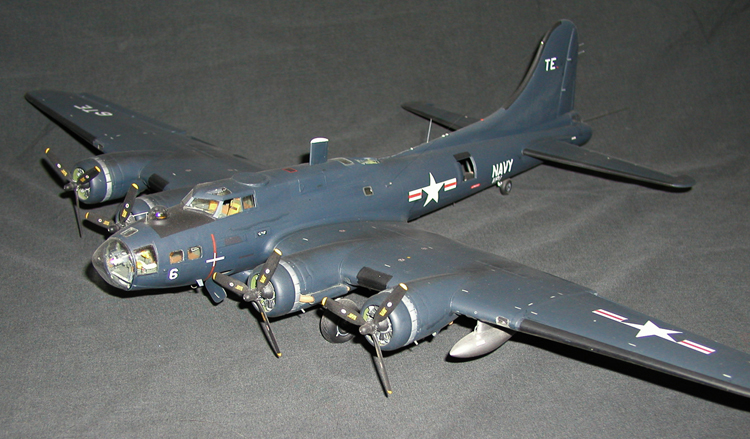
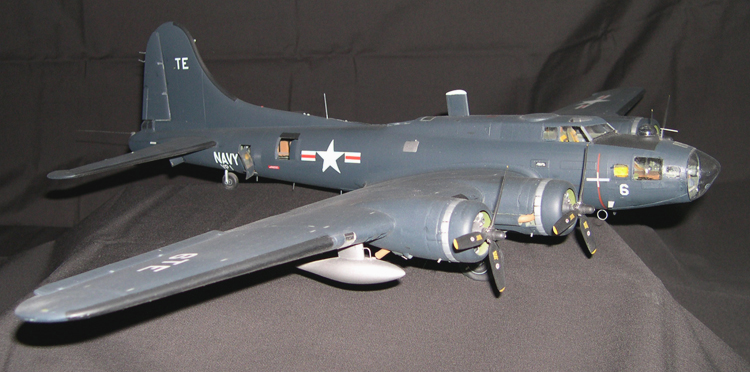
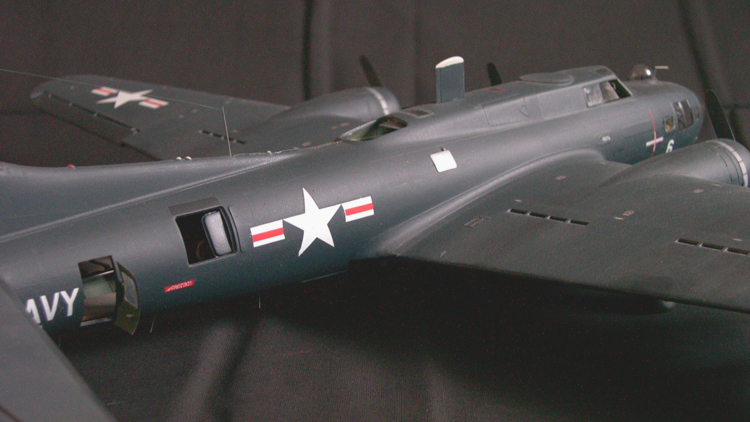
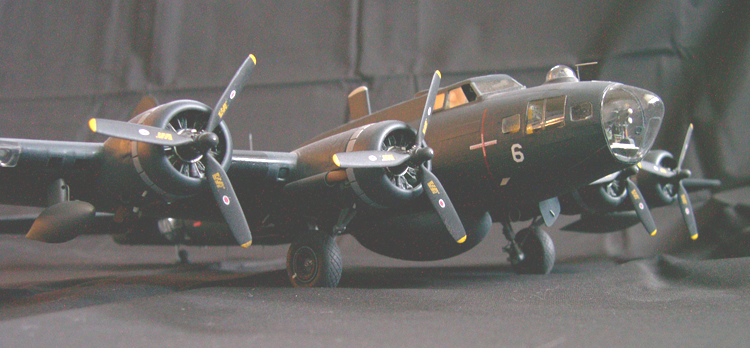
Be
sure to stop by and see Ian
M. Shaw's AEW Aircraft page |
|
Boeing
P2B-2S Superfortress
MODEL
DETAILS—Bet
you've never seen this! This is Mongrams' 1/48th scale B-29
Superfortress. The radome (you guessed it - stolen
from the Mongram AD-6W Skyraider 1:48 scale Kit)
needed very little modification. Doors and access hatches
were opened and flight surfaces were repositioned. Landing
gear, interior, engines and nacelles have also been detailed.
I am not entirely sure what the judges thought of it (the
sheer size of a 1/48th scale B-29 scared the hell out of several
small children) but it must have made an impression:
2002:
1st Place and Best of Show (Hobbytown, Sioux Falls SD);
2002: 1st Place, (Locon, IPMS Fort Crook/Omaha, NE)
Towards
the end of WWII, the US Navy modified several B-17-G-95-DL's
(Project Cadillac II) to carry the AN/APS-20 Search Radar
in a large down-looking radome slung from the bomb bay (see
above) - Sky-scanning versions sported a similar dome above
the fuselage as well - serving as the Worlds' first airborne
warning and command systems (AWACS). In 1951, the upper fuselage
of three USAF B-29's were modified to house the AN/APS-20
Search Radar. Aircraft interiors were also extensively modified
to house the radar and ECM equipment. The success of the program
triggered SAC to begin picket aircraft operations in 1954,
albeit using the more advanced EC-121 Constellation
(Navy WV-2). Had the Navy used the Boeing P2B Superfortress
aircraft to replace it's aging PB-1W Flying Fortress
aircraft serving with VP-1 (VW-1) out of Hawaii, it would
have looked very much like this aircraft depicted by this
very odd model.
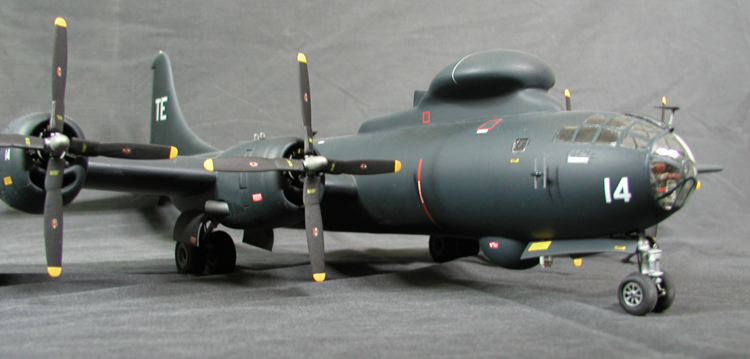
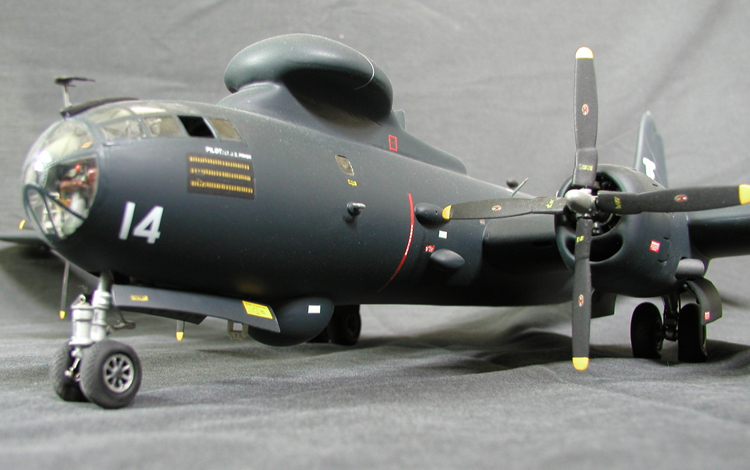
|
|
Consolidated
PB4Y-1/P4Y-1 Liberator
MODEL
DETAILS—
This
Monogram 1:48th scale B-24J Liberator was modified
to PB4Y-1 (redesignated P4Y-1in 1953) standard with a Koster
KAE vacu-form conversion. This simple "nose-job"
conversion from Koster was a very nice, simple piece of work.
During
World War II, the United States Navy modified several Consolidated
B-24 Liberator airframes to serve as long-range patrol aircraft.
Early PB4Y-1's differed little from their Air Force kin, but
later versions sported a more obvious upgrade in the form
of the bulbous ERCO bow turret (Engineering and Research Corp.).
After the war, many Navy P4Y-1 were refurbished and used for
training, transport, and support duties. The markings of this
P4Y-1 indicate that it operated out of the Naval Aviation
Ordnance Test Station at Chincoteague (NAOTS).

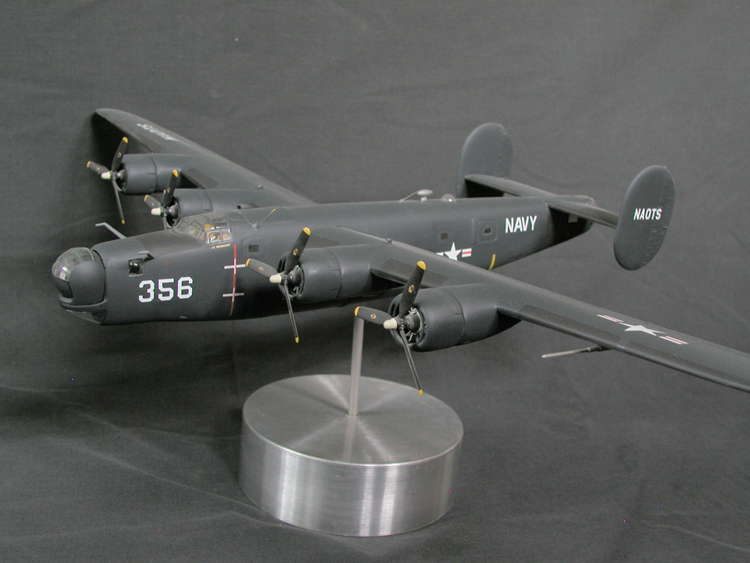
|
Consolidated
PB4Y-2/P4Y-2 Privateer
MODEL
DETAILS—This
PB4Y-2 model is a Koster Aero Enterprises vacu-form modification
of Monogram's 1:48th scale B-24J Liberator. All
that remain of the original kit are the cockpit decking,
bulk-heads, bomb bay, and wing planform. Cockpit and engines
have been detailed. Bomb bay doors, engine electrical harness,
engine nacelle vents, and de-icer boots are scrap-built.
This particular Koster conversion was well received (see
also the RY-3 below) and I think It turned out quite well.
The only issue that I had with this particular conversion
concerned the precise blending of the engine nacelles into
the stock Monogram wing planform. This model has also received
a bit of recognition from the judges:
1995:
Honorable Mention (Museum of Flight/NW Scale Modelers, Seattle,
WA);
2002: 3rd Place (Locon,
IPMS Fort Crook/Omaha, NE);
2003: 3rd Place (Hobby Town, Sioux Falls, SD).
The
PB4Y-2 patrol bomber was the second modification of the
basic B-24 (PB4Y-1) Liberator airframe ordered
by the Navy. The markings on this Privateer indicate that
it operated with VP-9 ("Golden Eagles") in Korea,
circa 1951. During the conflict, P4Y-2 Privateers
(Fireflies) dropped parachute flares to illuminate targets
which would then be attacked by orbiting nightfighters.
Privateers first flew in 1943 and were retired
from naval inventory in 1954. Many remained flying in Coast
Guard livery (P4Y-2G) until the early 1960's, while a few
modified "Super-Privateers" fly as slurry-bombers
in the US and Canada each summer fighting forest fires.
|
Consolidated-Vultee
RY-3 Liberator Express
MODEL
DETAILS—Bet
you have never seen this A/C modeled! This was my third
Koster KAE vacu-form modification of Monogram's 1:48th scale
B-24J Liberator (following the PB4Y-1 & PB4Y-2
- and believe it or not, I'm starting another PB4Y-1). All
that remains of the original kit are the cockpit decking,
bulk-heads, and wing planform. The side of the fuselage
was replaced by clear styrene sheet in order to get the
windows in where I needed them. Cargo
section, floors and doors were scrap-built; the passenger
door (right-side) and the Cargo door (left-side) were fun
touches for this model. The
judges even liked it, but only after I repainted it in 2002
from a less than effective bare-metal/silver to this rather
bright Hi-Vis Yellow.
2003:
1st Place (Hobby Town, Sioux Falls, SD).
The
RY-3 was the somewhat rare transport version of the Navy's
Consolidated PB4Y-2 Privateer patrol bomber and
was designated RY-3 Liberator Express. These aircraft were
equipped with a passenger door on the right side of the
fuselage just aft of the crew compartment and a large cargo
door on the left side of the aft fuselage.
The RY-3 differed from the PB4Y-2 in having no armament
and in having a series of windows along the fuselage. Fairings
were installed where the nose and tail turrets had been.
A crew of four and 28 passengers, or 8 tons of cargo could
be carried. Four Pratt & Whitney R-1830-94 14-cylinder
(not turbocharged) air cooled radial engines rated at 1350
hp could push the aircraft along at 250 mph (12,000 feet),
but cruising speed was a turtle-like 158 mph. Only 34 RY-3s
were actually built and very few actually ended up serving
with the Navy.
|
Martin
JM-1 Marauder
MODEL
DETAILS—The
basic kit is Monogram's 1:48th scale B-26B Marauder
modified to a Navy JM-1. The Navy and Marine Corps utilized
approximately 250 B-26 Marauders as gunnery target tugs, designating
them JM-1 (AT-23B) or JM-2 (TB-26G) Marauder. Aircraft
were devoid of armor & armament but were outfitted with
two 1850 hp P&W R-2800-43 Double-Wasp engines. In this
stripped-down configuration, they were the cleanest &
fastest Marauders in production. Each aircraft was
provided with a C-5 windlass in the bomb bay which was used
to deploy a wide range of gunnery targets. Many tugs were
unpainted but several were painted in this garish, high-visibility,
chrome-yellow. I
always thought that the Marauder was an elegant,
clean design, and a JM would have been an excellent project
to exhibit these lines...but instead of leaving it buttoned-up,
I repositioned all
flight surfaces; opened both fore and aft bomb bays and detailed
the interior with the winch and cable-guides; detailed the
cockpit, engine bay; and added a resin engine. The gunnery
target is scratch built, and the tractor has been heavily
modified.

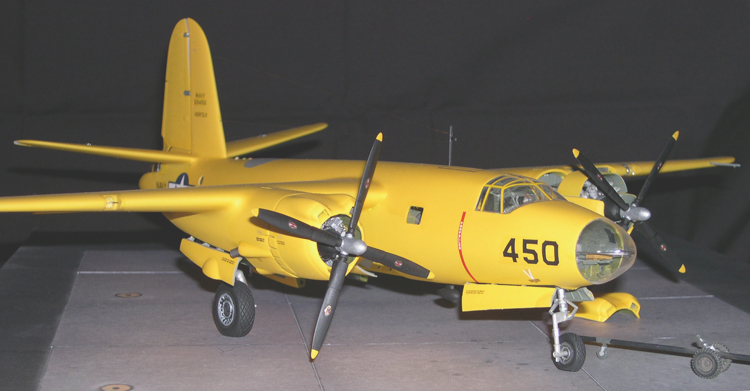
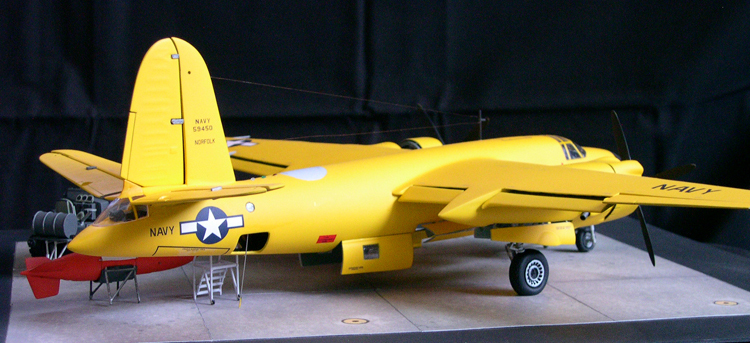
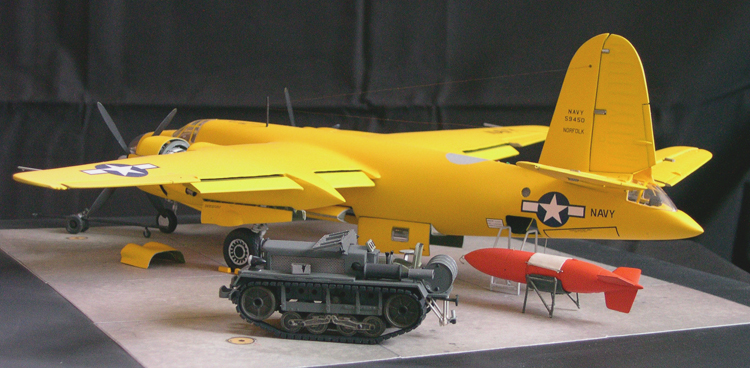

|
|
North
American PBJ Mitchell
MODEL
DETAILS—Nothing
fancy here, just another tribute to a "Bomber in Blue".
This is a simple conversion of
Monograms' 1:48 Scale B-25. The only real modification is
the radome on the starboard wingtip.
This model has received a bit of recognition:
1998: 2nd Place (Northwest Scale Modelers, Seattle, WA)
2002: 3rd Place (Hobby Town, Sioux Falls, SD)
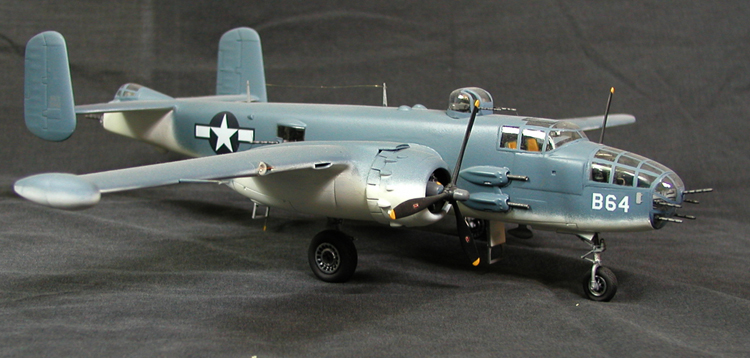

|
Grumman
TBM-3W "Guppy"
MODEL
DETAILS—This
model of a TBM-3W is a rather extensive conversion of an old
Monogram 1:48th scale TBM-3 Avenger (German mold).
The kit molding was actually that of a TBM-1, which necessitated
the scratch-building of new cowl-flaps, oil-cooler intakes,
cockpit, aft-canopy, and aft-fuselage (a VERY nice resin conversion
is "NOW" available from MDC - just my luck!). Tail-code
designates this TBM-3 as belonging to VS-32.
AN/APS-20
Search Radar
- The bulbous radome of the AN/APS-20 search radar was carried
aloft by numerous United States Navy aircraft: Grumman TBM-3W
Avengers, Boeing PB-1W Flying Fortresses,
Grumman AF-2W Guardians, Lockheed P2V-3 through P2V-7
Neptunes, Douglas AD-2W through AD-6W Skyraiders,
and early Lockheed WV-1 Constellations.

Be
sure to stop by and see Ian
M. Shaw's AEW Aircraft page
|
Northrop
F2T-2 Reporter
MODEL
DETAILS—This
kit-bashed conversion of Monogram's 1:48th scale P-61A Black
Widow represents what a Navy F2T-2 Reporter
would have looked like in the guise of VW-4's "Hurricane
Chasers."
After
World War Two, the Air Force needed a new long-range, high-speed
recon aircraft. The XF-15 was a late production P-61B (XP-61E)
that had its guns, radar, and air-brakes removed, a bubble
canopy was fitted, and the nose was filled with a battery
of cameras. Production F-15A's (RF-61C) utilized P-61C airframes,
engines, and a re-worked camera bay. Even with the "Jet
Age" on the horizon, 175 Reporters were ordered,
but only 36 were built, and after only 22 months of active
service (8th PRS) most were scrapped in 1949. The Navy had
experience operating F2T-1's (P-61C Black Widows)
in 1946 and 1947 as transition aircraft to train Marine
Crops nightfighter crews in intercept tactics before they
moved on to the Grumman F7F Tigercat. The F-15A/F2T-2
would have made a kick-ass stable-mate to Navy PB1-W and
PB4Y-2 reconnaissance aircraft. The appearance of Lockheed's
P2V Neptune in 1947 doomed any further development
of a Navy F2T-2 Reporter concept.
Regardless,
you have to love the looks of the Reporter, even
if it was only used by the USAF- it was a VERY aggressive-looking
yet attractive aircraft!
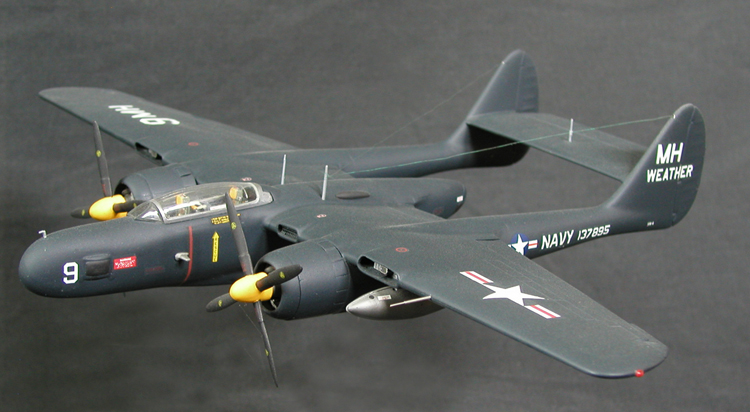
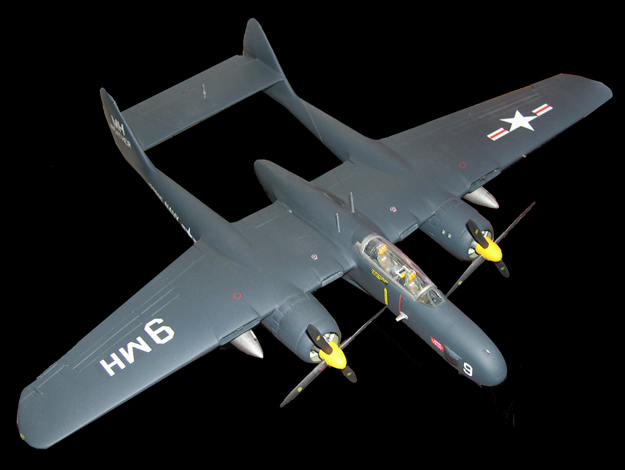
|
Consolidated
PBY-5A Catalina
MODEL
DETAILS—Nothing
fancy here. Just a standard Monogram PBY-5A, albeit, I bashed
the tail into the correct thinness and profile BEFORE the
damn resin kit came out which would have made my job a helluva-lot
easier!!!! No matter, I orange-peeled some of the paint and
quickly put this on a back-shelf where it is still gathering
dust.
Nevertheless,
it received recognition: 2002: 3rd Place (Hobby Town, Sioux
Falls, SD).

|
Martin
PBM-5A Mariner
MODEL
DETAILS—This monster
1:48th Combat Models vacu-form kit was my first attempt at
a 100% vacuform kit. Bad-idea. I had a VERY difficult time
keeping the wings from sagging badly (I failed - they needed
a very stiff internal spar - I'd suggest aluminum stock) and
the plastic along the hull was very thin in places and after
two years it was showing significant puckers that I do not
remember noting during the original build. The kit has great
promise, but it needs a real vacu-form expert and a tremendous
amount of internal support, in fact, I'd suggest blowing the
entire frame full of foam. Too, the profile of the bow-section
does not look quite right, and does not match the photographic
material I have....I did NOT attempt to remedy this issue
as I was having too many other problems wrestling this beast
into shape. I
built this one as the amphibian-version PBM-5A, though the
original kit is for the sea-version only. There was little
or no surface detail provided with this kit, but with the
huge expanses of plastic, this model screams for some surface
relief. Certainly, for Vacu-form ghouls, the size of this
huge model avails it to some SERIOUS detailing! I found that
the aftermarket resin material now available for Monogram's
1/48th PBY were quite close to what I needed for the PBM interior.
This model has received recognition, though I have no doubt
that the ribbons were "in sympathy" for the effort
involved rather than for the results:
1997: 3rd Place (American Eagles Hobby, Seattle WA).
1997: 3rd Place (Northwest Scale Modelers, Seattle WA).
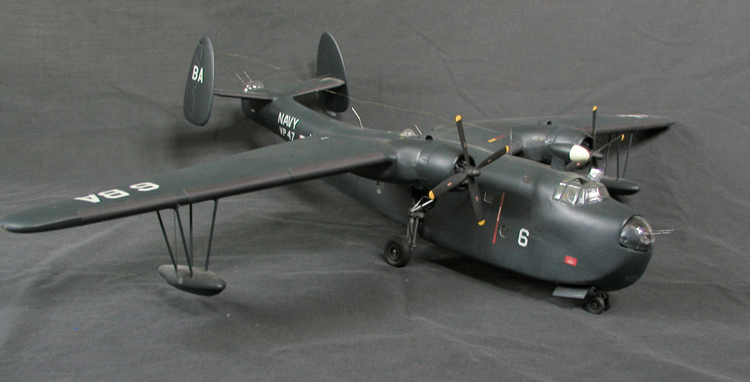
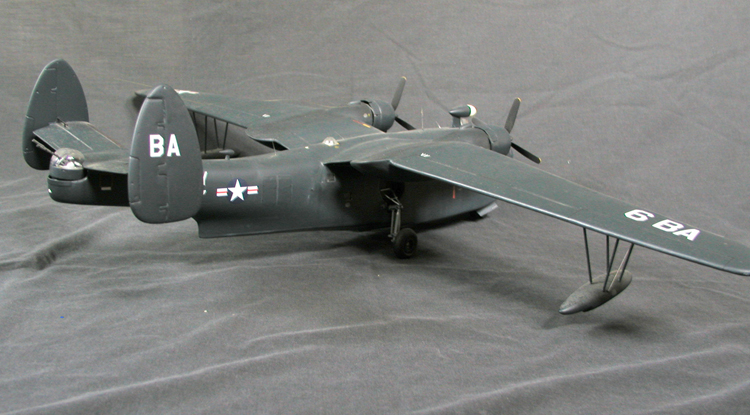
|
|
Return
to Nav-Bar at top of Page
Be
sure to stop by and see Ian
M. Shaw's AEW Aircraft page
|
|